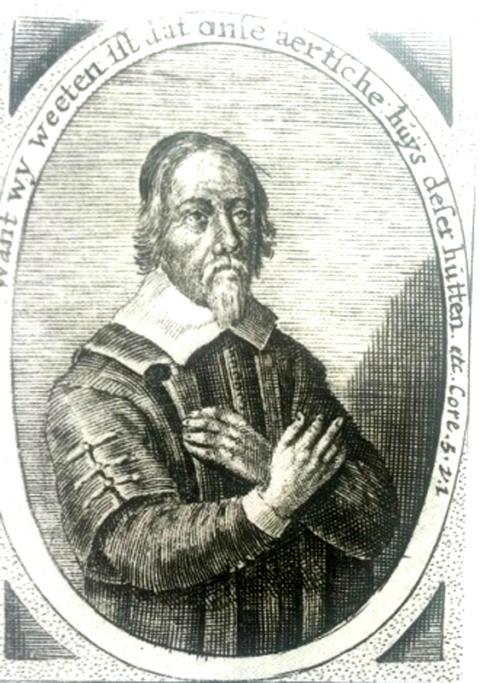On Saturday, Taiwan was the focus of activities in Schipluiden, a small village between The Hague and Rotterdam in The Netherlands.
The occasion was the unveiling of a monument commemorating Reverend Anthonius Hambrouck, who was a pastor in the old church in the village from 1632 until 1647, when Hambrouck left with his wife and four children, and sailed to faraway Formosa (a journey of almost one year). The church and the pulpit in the church remain the same as when Hambrouck left in 1647.
In Formosa, the Dutch East India Company had established its Fort Zeelandia in 1624 and built up a prosperous colony. Part of the work of the colony was to bring the gospel to the Aboriginal Siraya people, and establish schools and medical clinics in the area around today’s Anping (安平) in Tainan.

photo courtesy of Gerrit Van Der Wees
The first pastor to work in the area was Reverend George Candidius, who arrived in 1627 but refused to live at the fort, and instead made Sincan (present-day Sinshih District, 新市區) his home.
When Hambrouck arrived in 1647, he set up his parish in Mattau (today’s Madou District, 麻豆區) which in the early years had been hostile to the incoming Dutch — and at war with neighboring villages such as Sincan — when Candidius had been the pastor.
Hambrouck started preaching, and also began a school, and initially had some 145 male students, who received education “from the cock’s crowing.” The education gradually expanded, and Hambrouck started classes for girls and women in the afternoon. He trained a number of Aboriginal men as assistant teachers.

photo courtesy of Gerrit Van Der Wees
The ceremony in Schipluiden honored Hambrouck for his work, and particularly his role in establishing the written version of the Siraya language, which is currently undergoing revival efforts.
The plaque that was jointly unveiled by Taiwan representative Tom Chou (周台竹) and current Schipluiden pastor Erika Dibbets-van der Roest shows text taken from the Bible’s Gospel of St. Matthew in both old-Dutch and the Siraya language. The piece of art was a work by a former resident of Schipluiden, Marcel Koeleman.
The village of Schipluiden also decided to honor Reverend Hambrouck by naming the square in front of the church “Hambrouckplein” (Hambrouck square). The mayor of the village, Arnoud Rodenburg, and the town’s councilmember for culture and monuments Wendy Renzen jointly unveiled the new name plate.
Hambrouck became most famous in his role as intermediary after the landing of Cheng Cheng-kung (鄭成功, also known as Koxinga) in late April 1661. Koxinga and his 25,000 invading troops had been able to occupy the countryside area around Fort Zeelandia, but not the heavily defended fort itself.
Koxinga arrested and imprisoned some 500 Dutch who lived in the 40 villages around Fort Zeelandia, and selected Hambrouck to go to the fort and ordered him to convince Governor-General Frederic Coyett to surrender. Koxinga kept Hambrouck’s wife, one daughter and son as hostages. The other two married daughters lived at the fort.
When Hambrouck met Coyett, he urged him not to surrender, but to hold out until reinforcements from Batavia (present day Jakarta) would arrive. His two daughters at the castle begged him to stay (a big painting at today’s Anping Old Fort depicts the scene), but Hambrouck wanted to safeguard the lives of his wife and son and daughter, and returned to Koxinga’s headquarters at Fort Provintia, handing Koxinga the negative answer of Coyett. Koxinga subsequently had Hambrouck killed.

On April 26, The Lancet published a letter from two doctors at Taichung-based China Medical University Hospital (CMUH) warning that “Taiwan’s Health Care System is on the Brink of Collapse.” The authors said that “Years of policy inaction and mismanagement of resources have led to the National Health Insurance system operating under unsustainable conditions.” The pushback was immediate. Errors in the paper were quickly identified and publicized, to discredit the authors (the hospital apologized). CNA reported that CMUH said the letter described Taiwan in 2021 as having 62 nurses per 10,000 people, when the correct number was 78 nurses per 10,000

As we live longer, our risk of cognitive impairment is increasing. How can we delay the onset of symptoms? Do we have to give up every indulgence or can small changes make a difference? We asked neurologists for tips on how to keep our brains healthy for life. TAKE CARE OF YOUR HEALTH “All of the sensible things that apply to bodily health apply to brain health,” says Suzanne O’Sullivan, a consultant in neurology at the National Hospital for Neurology and Neurosurgery in London, and the author of The Age of Diagnosis. “When you’re 20, you can get away with absolute

May 5 to May 11 What started out as friction between Taiwanese students at Taichung First High School and a Japanese head cook escalated dramatically over the first two weeks of May 1927. It began on April 30 when the cook’s wife knew that lotus starch used in that night’s dinner had rat feces in it, but failed to inform staff until the meal was already prepared. The students believed that her silence was intentional, and filed a complaint. The school’s Japanese administrators sided with the cook’s family, dismissing the students as troublemakers and clamping down on their freedoms — with

As Donald Trump’s executive order in March led to the shuttering of Voice of America (VOA) — the global broadcaster whose roots date back to the fight against Nazi propaganda — he quickly attracted support from figures not used to aligning themselves with any US administration. Trump had ordered the US Agency for Global Media, the federal agency that funds VOA and other groups promoting independent journalism overseas, to be “eliminated to the maximum extent consistent with applicable law.” The decision suddenly halted programming in 49 languages to more than 425 million people. In Moscow, Margarita Simonyan, the hardline editor-in-chief of the